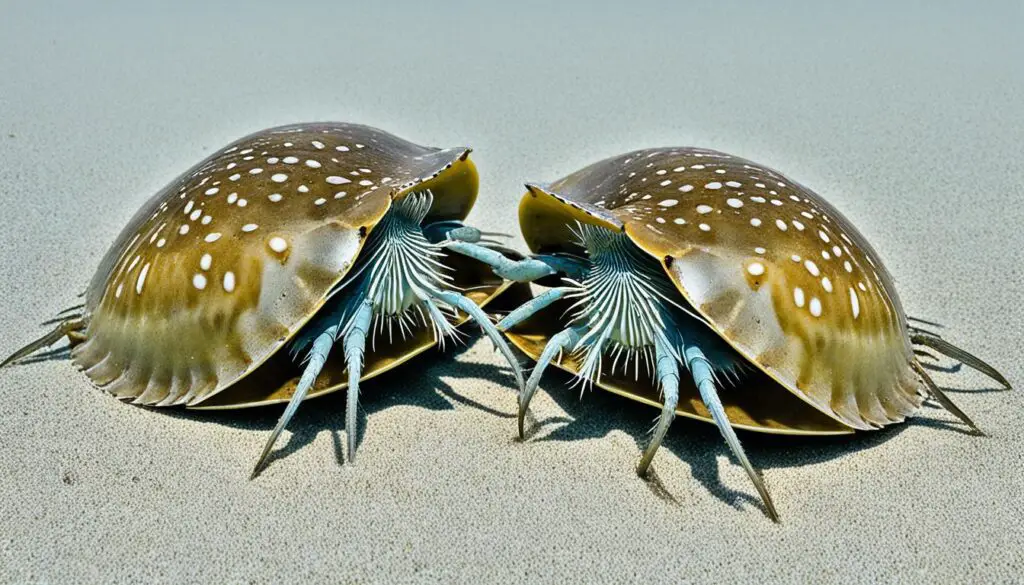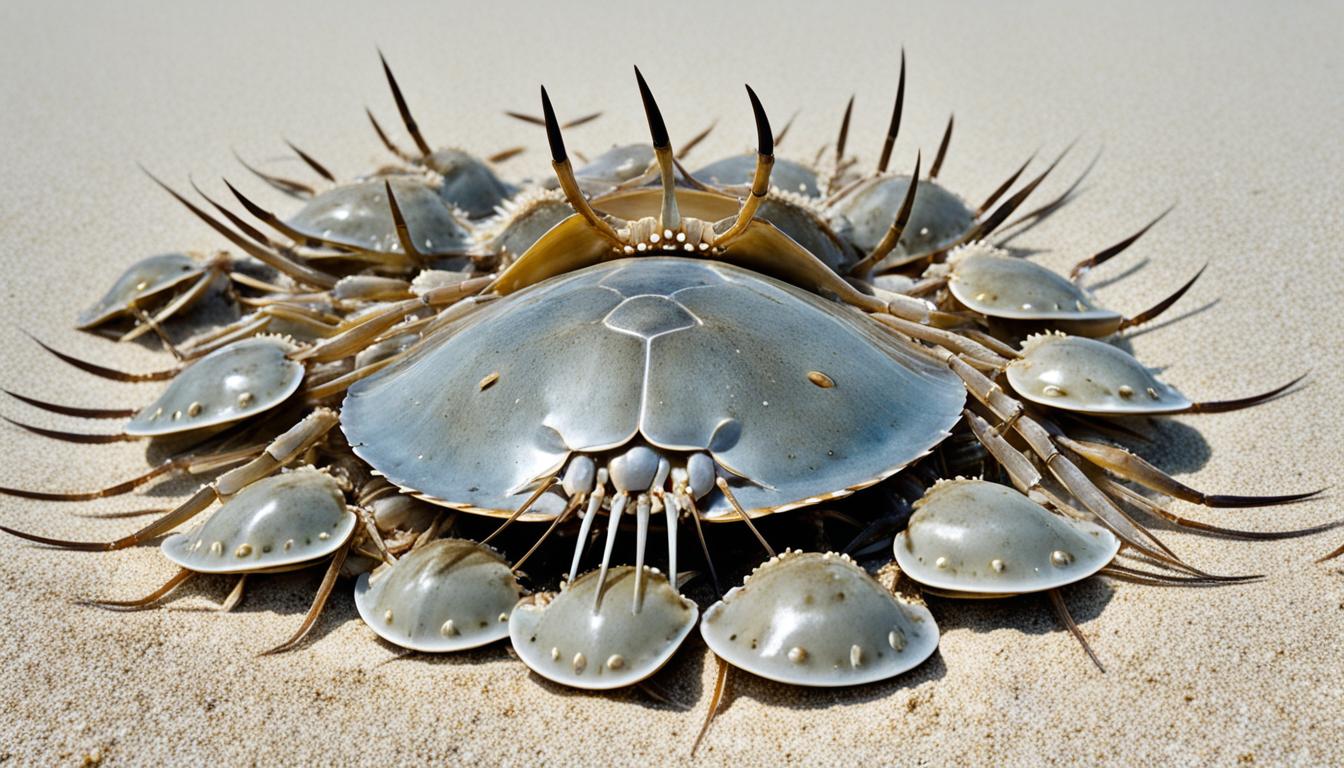Learning about horseshoe crab reproduction helps us understand their amazing survival skills. These creatures are called “living fossils” because they look and behave the same way they have for over 445 million years. The Limulus polyphemus is a key species found along the Atlantic and Gulf coasts. It has special ways of breeding that help keep its population strong.
This article will explore the details of how horseshoe crabs reproduce. It will highlight their ability to adapt and survive in a changing world.
Understanding Horseshoe Crab Reproductive Biology
To understand horseshoe crabs’ reproductive biology, we must first look at their definition and classification. They are not true crabs but belong to a group called Merostomata, related to spiders and arachnids. This fact helps us see their role in evolution.
Definition and Classification
There are four main horseshoe crab species, with Limulus polyphemus found only in North America. Their unique evolution sets them apart from other sea creatures. Seeing them as living fossils helps us understand their role in the ocean and their impact on marine life.
Anatomy and Physical Characteristics
The horseshoe crab’s body is simple, made up of three parts: the prosoma, opisthosoma, and telson. Each part has a special job in helping them survive. They have ten eyes to help them find food and breathe through book gills under their shell.
They also have special claws for mating, showing how they’ve evolved to reproduce better. These features are key to their survival and reproductive success.
How do horseshoe crabs reproduce?
The way horseshoe crabs reproduce is quite fascinating. Males use their front claws to hold onto females during mating on sandy beaches. This happens around new and full moons, when they spawn the most.
Females come to the shore and can lay about 80,000 eggs. They come back several times, making clusters that help with fertilization. With males around, the chances of successful mating go up, making it perfect for their eggs.
This breeding behavior is key to their survival. It not only boosts their reproductive success but also keeps their life cycle going strong.
Horseshoe Crab Mating Behavior
The mating of horseshoe crabs is a fascinating process. It shows how important chemical signals and male competition are. During the breeding season, females release special chemical signals. These signals draw males to them on the beach. This helps ensure they have the best chance to reproduce.
The Role of Pheromones
Pheromones play a big part in horseshoe crab mating. Females send out these chemical signals that males can pick up from far away. When males find these signals, they start moving towards the female. This helps increase their chances of mating during a short breeding window.
Male Competition and Clasping
Male horseshoe crabs compete with each other during mating. Smaller males often cling to bigger females to increase their chances of fertilizing eggs. This can create groups of males around one female, all trying to mate. This competition helps ensure that many males get a chance to fertilize the eggs.

The Horseshoe Crab Spawning Process
The horseshoe crab spawning process is amazing. It happens on sandy beaches, where many come together at certain times of the moon’s cycle. This helps the eggs survive better.
Nesting Aggregations
Many horseshoe crabs gather on the shore, usually during high tides at full or new moon. This is when females look for the best places to lay their eggs. With so many crabs around, there’s more competition among males but also more safety for the nests.
Egg Laying
At the nesting site, females lay their eggs in a special way. They dig into the sand and put down big groups of eggs. These groups can have up to 4,000 eggs, which is crucial for their survival. After that, the eggs become food for many birds, showing how important this process is for nature.
| Aspect | Details |
|---|---|
| Timing of Spawning | High tides during new or full moon |
| Total Eggs Laid | Approximately 4,000 per female |
| Ecological Role | Food source for migratory shorebirds |
| Nesting Behavior | Aggregation at sandy beaches |
Life Cycle and Development of Horseshoe Crabs
The life of horseshoe crabs starts with the hatching of larvae weeks after fertilization. These larvae come out of the sandy flats where they were laid. They look a lot like adults but have smaller tails that grow as they get older.
Juvenile horseshoe crabs go through a process called molting to grow. They shed their shells and get bigger during this time. They molt many times before they are ready to have babies, usually around nine years old.
Horseshoe crabs can live up to 20 years in the wild. This shows how important they are in the ocean. Knowing about their life cycle helps us protect them for the future.
FAQ
How do horseshoe crabs reproduce?
Horseshoe crabs reproduce by a unique process. Males grasp females on sandy beaches during mating. This happens during new and full moons. Females lay about 80,000 eggs in clusters, while males fertilize them.
What makes horseshoe crab reproduction unique?
Their mating behavior is special. Females use pheromones to attract males. They also spawn in large groups, tied to the moon’s cycles.
How do horseshoe crabs ensure high fertilization rates?
Many males gather around a female during spawning. This increases the chance of successful fertilization of the eggs laid in clusters.
What role do pheromones play in horseshoe crab mating?
Pheromones are key in mating. They help females send chemical signals to males, drawing them to the beach during spawning season.
How do horseshoe crabs lay their eggs?
Females bury themselves in sandy beaches to lay eggs. They deposit large clusters, usually 4,000 eggs each, for better fertilization conditions.
What is the significance of horseshoe crab eggs?
Horseshoe crab eggs are vital. They are a key food source for migrating shorebirds, playing a big role in the marine ecosystem.
How long does it take for horseshoe crab larvae to hatch?
Larvae hatch several weeks after fertilization. They turn into juvenile crabs that look like adults but have smaller tails.
What is the life cycle of a horseshoe crab?
Horseshoe crabs go through many stages from larvae to juvenile crabs. Juveniles molt several times before reaching maturity at nine years old.
How long can horseshoe crabs live?
In the wild, horseshoe crabs can live up to 20 years. This shows their resilience and importance in their marine homes.







